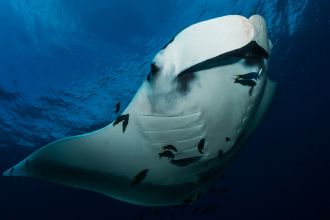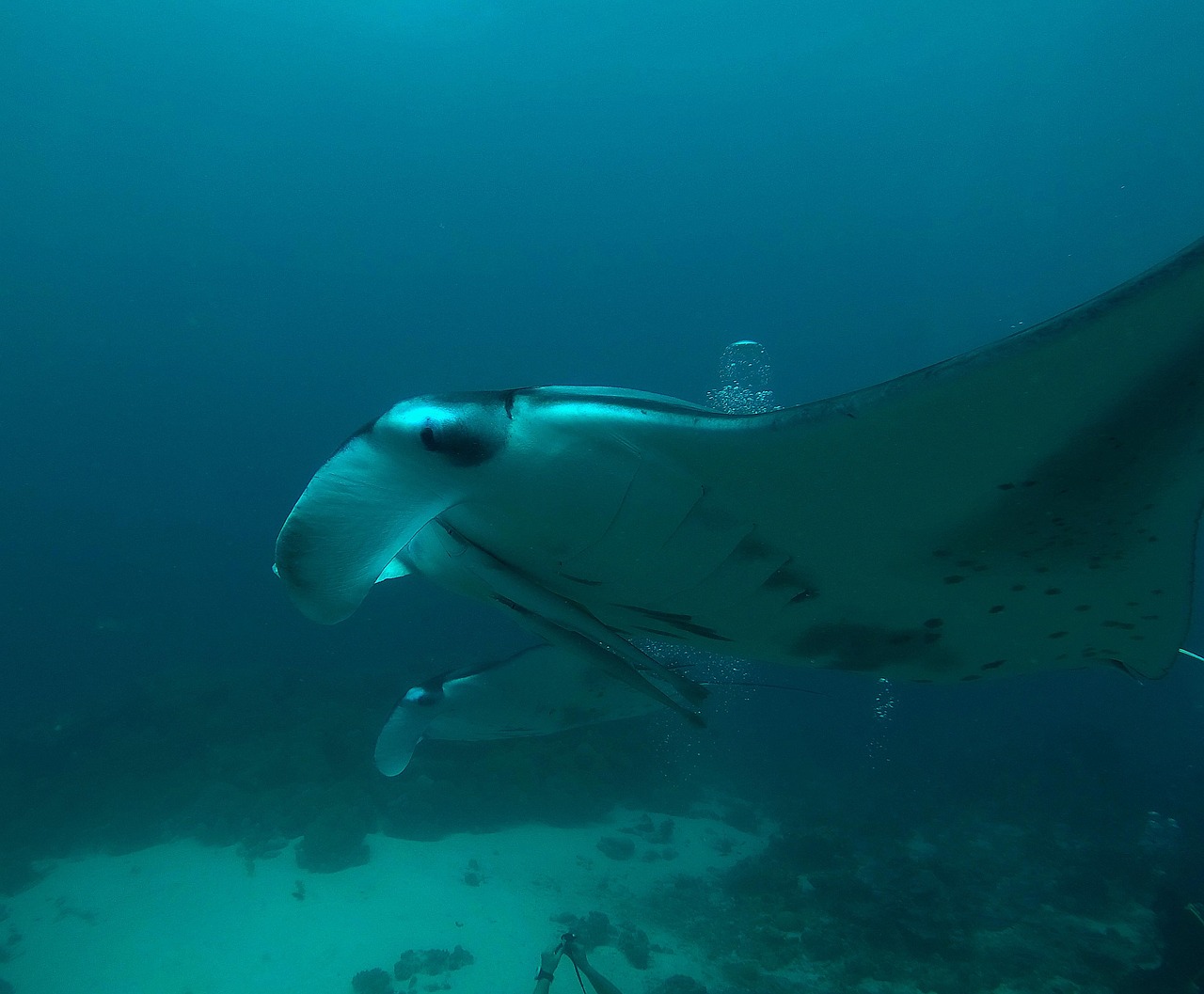Media release
From:
World’s largest rays may be diving to extreme depths to build mental maps of vast oceans
Oceanic manta rays may dive many hundreds of meters deep – far deeper than once thought – for navigation and orientation after leaving coastal waters, find researchers who tracked mantas across the globe
When we leave familiar areas, we might need a moment to reorientate ourselves. Similarly, oceanic manta rays, the largest species of ray which travels thousands of kilometers between habitats, may need to gather information about their new surroundings after moving away from the coasts. They are capable of diving to extreme depths, up to more than 1,200 meters – and a new study showed that this behavior might help them navigate across the open ocean. These extreme dives could help the animals sample environmental cues and allow them to travel between ecosystems.
Many marine species are no strangers to the depths of the oceans. Some animals, like certain sharks, tuna, or turtles, routinely perform extreme dives, whereas for other species such behavior has been observed less frequently.
Now, an international team of researchers working in Peru, Indonesia, and New Zealand tagged oceanic manta rays – the largest species of ray – to learn more about the deep-diving behavior of these animals. They published their results in Frontiers in Marine Science.
“We show that, far offshore, oceanic manta rays are capable of diving to depths greater than 1,200 meters, far deeper than previously thought,” said first author Dr Calvin Beale, who completed his PhD at Murdoch University. “These dives, which are linked with increased horizontal travel afterwards, may play an important role in helping mantas gather information about their environment and navigate across the open ocean.”
Under the sea
The team tagged 24 oceanic manta rays at three sites, Raja Ampat in eastern Indonesia, near Tumbes off the coast of northern Peru, and near Whangoroa in northern New Zealand. They observed mantas’ diving behavior between 2012 and 2022. Eight of the tags, programmed to release after several months, were recovered after floating back to the surface. “It is quite a challenging task, trying to spot a small gray floating object with a short antenna bobbing around in the waves with other flotsam and jetsam,” Beale said. High-frequency data was downloaded every 15 seconds from the recovered tags. The 16 non-recovered tags transmitted summary data via satellite.
In total, 2,705 tag-days of data were recorded. On 79 days, mantas dived to extreme depths, reaching a maximum of 1,250 meters. 71 of these extreme dives, defined as deeper than 500 meters, happened in the waters off New Zealand.
The data showed that New Zealand mantas usually initiated an extreme dive within a day after moving off the continental shelf and into deeper waters. The dives were characterized by a stepped decline and little to no time spent at maximum depths. This suggests that the animals didn’t dive this deep to forage or escape hunters, some of which can reach equal diving depths.
Instead, mantas may use cues such as changes in the Earth's magnetic field strength and gradient, or sample changes in oxygen, temperature, and even light levels. “By diving down and ‘sampling’ these signals, they could build a mental map that helps them navigate across vast, featureless stretches of open ocean,” Beale explained. Sampling deep below the surface may help because at great depths the ocean environment is more stable and predictable than at the surface.
Stepped resurfacing and prolonged periods of recovery back at the surface concluded these dives. They were often followed by extended movement over the next few days, covering distances of more than 200km. This further consolidates the theory that extreme dives may serve other functions than foraging.
Deep diving
In Peru and Indonesia, few extreme dives were recorded, which might be due to manta rays’ habit of remaining in shallower coastal habitats. In Raja Ampat, for example, the seas are mostly shallow and the few deep-water corridors are relatively short, giving mantas less need to seek navigation information. In New Zealand, however, oceanic manta rays were moving through deep offshore habitats where the seafloor drops away quickly, making extreme dives possible and necessary.
“Understanding the nature and function of deep dives helps explain how animals cross vast, seemingly featureless oceans and connect ecosystems thousands of kilometers apart,” Beale pointed out.
The study used relatively few tags and analyzed behavioral snapshots rather than continuous tracks, the researchers pointed out. They said that future studies should use larger datasets and confirm the function of deep dives performed by oceanic manta rays.
“Our study highlights how dependent migratory species are on both coastal and offshore habitats, stressing the need for international cooperation in their conservation,” Beale concluded. “It also reminds us that the deep ocean – which regulates Earth’s climate and underpins global fisheries – remains poorly understood but vitally important.”
Expert Reaction
These comments have been collated by the Science Media Centre to provide a variety of expert perspectives on this issue. Feel free to use these quotes in your stories. Views expressed are the personal opinions of the experts named. They do not represent the views of the SMC or any other organisation unless specifically stated.
Dr Mark Erdmann, Shark Conservation Director, Re:wild
“This study is the first of its kind to examine in detail the extreme deep diving behaviour of oceanic manta rays (Mobula birostris).
“Twenty-four oceanic manta rays were satellite tagged in Indonesia, Peru and New Zealand. The nine individuals tagged in New Zealand between 2019 and 2022 (all in the Hauraki Gulf, as part of a collaboration between the Department of Conservation, Manta Watch New Zealand, Conservation International Aotearoa and Tindale Marine Research Charitable Trust) recorded the deepest dives by far, with all nine exceeding 1000m in their deepest dives, and eight of the nine exceeding 1200m - experiencing temperatures as cold as 4.6ºC during these dives!
“The paper examines these dives in detail, and concludes that the likely reason the mantas braved the cold, dark, deep waters was not in search of food, nor to avoid predators - but likely for navigational purposes. We now know that many, if not all, of the oceanic mantas that feed off New Zealand’s North Island in the summer months eventually migrate northwards towards warmer waters (including around Fiji and Tonga) as the seas around New Zealand cool off in the autumn and early winter.
“The deep dives of New Zealand oceanic mantas all occur as they leave the continental shelf and began their northward migration, and it seems likely the dives are conducted in order to “take a better bearing” of the magnetic lines on the bottom of the ocean. The study shows that immediately after deep dives, NZ oceanic mantas spend a fair bit of time warming up on the surface (likely recovering from the thermal stress of these very cold deep waters), but then start moving “with a purpose” - covering up to 200km per day in a highly directional manner for several days in a row.
“Importantly, the research team in New Zealand has continued to satellite tag oceanic mantas every summer since 2019, and expects to publish additional exciting insights into the movements and behaviours of these majestic creatures over the coming few years.”
Multimedia





















 Australia; New Zealand; International; WA
Australia; New Zealand; International; WA



